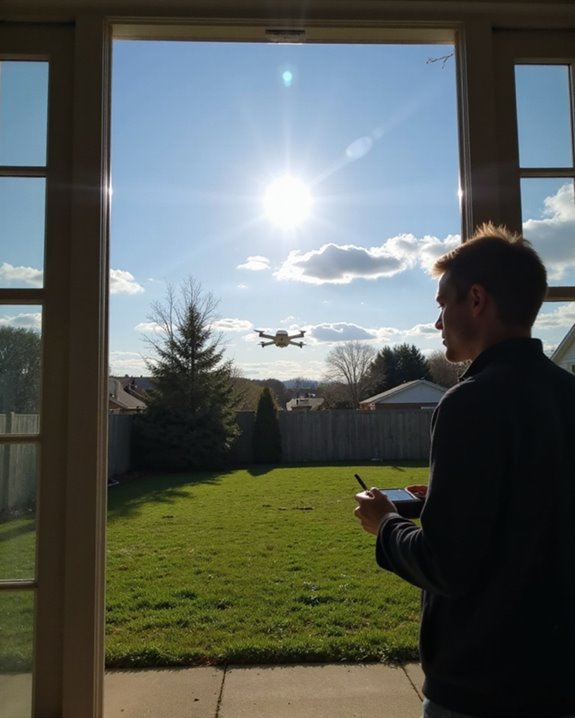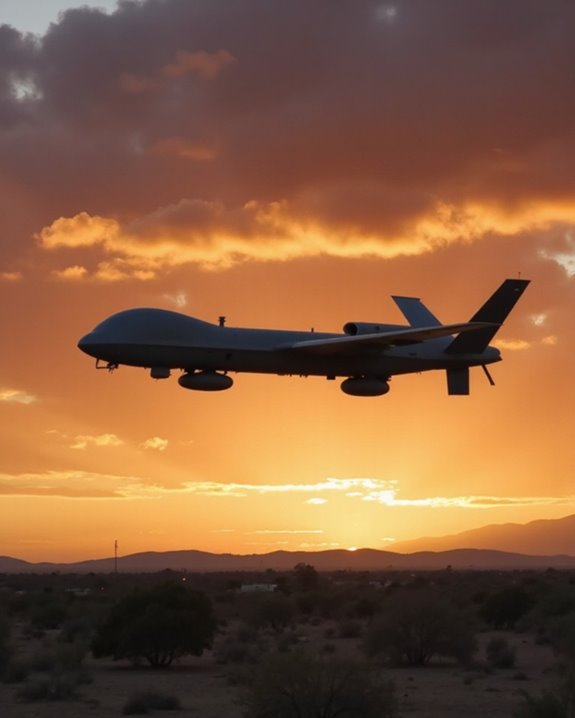Yes, pilots can fly drones from inside, but significant challenges exist. Signal interference from walls and windows weakens transmission, potentially causing control issues or flyaways. Legal requirements still apply—maintaining visual line of sight (often requiring a spotter outside) and following airspace rules. Position near windows or doorways for best signal strength, and enable Return-to-Home features as a safety precaution. Modern drones with enhanced transmission technology make indoor piloting more feasible, but outdoor supervision remains the safest approach.
Key Takeaways
- Flying a drone outside from inside is possible but requires proper signal transmission through windows or doorways.
- Building materials like concrete and metal significantly block controller signals, requiring strategic indoor positioning.
- Position yourself near windows for direct line of sight to maintain reliable drone connection.
- Legal requirements mandate visual line of sight, making indoor control potentially problematic for compliance.
- Enable Return to Home function before flying from inside to ensure drone safety if signal connection drops.
The Basics of Remote Drone Operation
The fascinating world of remote drone operation begins with understanding the fundamentals that keep both the operator and the public safe. Before your drone takes flight, mastering Control Basics like throttle, directional movement, and yaw rotation is essential for confident piloting!
Flight Fundamentals require more than just pushing buttons—they involve careful pre-flight checks and maintaining awareness of your surroundings, even when you’re indoors. Every successful flight starts with equipment verification, battery assessment, and understanding emergency procedures like the Return to Home function. Remember, your remote controller is your lifeline to that expensive gadget hovering outside your window!
With regular practice, you’ll develop the muscle memory needed to smoothly shift between hovering, moving forward, and executing controlled turns—skills that transform nervous beginners into capable pilots. Choosing the right drone controller can greatly enhance your control experience and ensure reliable video transmission during flight.
Technical Challenges of Indoor-to-Outdoor Control
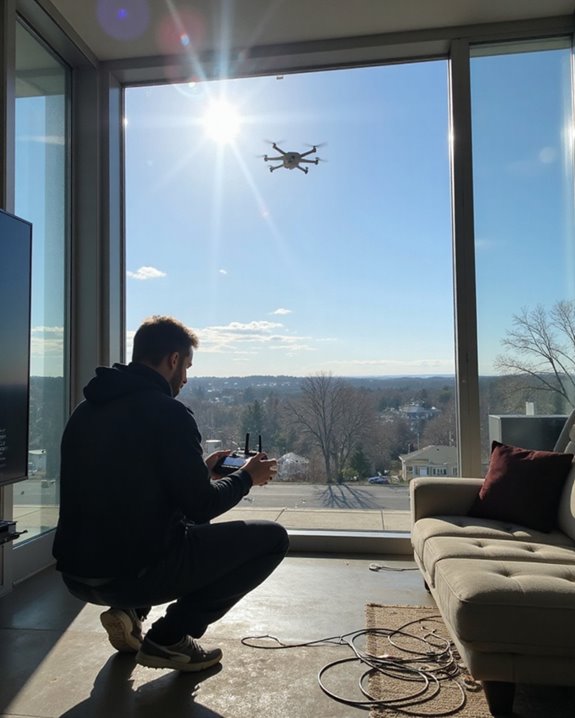
While mastering those basic controls builds confidence in your piloting abilities, flying a drone from inside adds significant technical hurdles to the experience. Your drone faces a jarring shift when moving between environments, with GPS signals suddenly appearing or disappearing as it crosses thresholds!
Modern drones employ Stability Algorithms that must instantly adjust to changing air conditions and sensor inputs when flying from confined spaces to open skies. The real magic happens through Sensor Fusion Techniques, where data from cameras, ultrasonic sensors, and compasses work together to maintain position awareness. Unfortunately, walls and building materials can block your control signals, potentially causing connection drops just when you need precision the most. Plus, those magnetic fields from indoor wiring? They’ll confuse your drone’s compass faster than a toddler in a mirror maze!
Additionally, indoor drones rely heavily on optical flow positioning to stabilize flight in GPS-denied environments, a technology that struggles when transitioning outdoors.
Legal Requirements for Remote Piloting
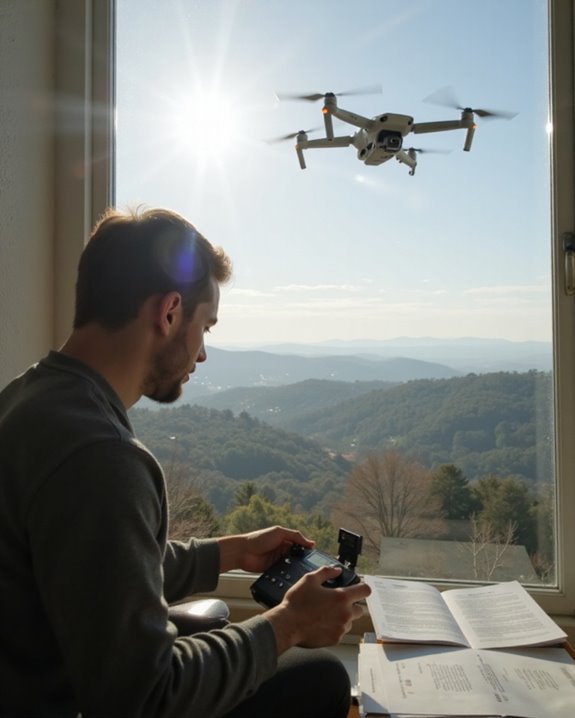
Flying a drone from inside your cozy living room might feel like casual fun, but a tangled web of legal requirements awaits pilots who don’t do their homework! The FAA mandates that remote pilots must be at least 16 years old, understand English, and maintain their drones in safe operating condition.
Commercial pilots need a Part 107 license, which requires periodic License Renewal to stay current with evolving regulations. Don’t forget that recreational flyers need to pass the TRUST exam too! Even when piloting from indoors, you’re still bound by visual line-of-sight requirements, airspace restrictions, and prohibitions against flying over people. Additionally, legal restrictions prohibit civilian use of drone jammers, so pilots must rely on compliant tracking solutions.
Signal Strength and Transmission Barriers
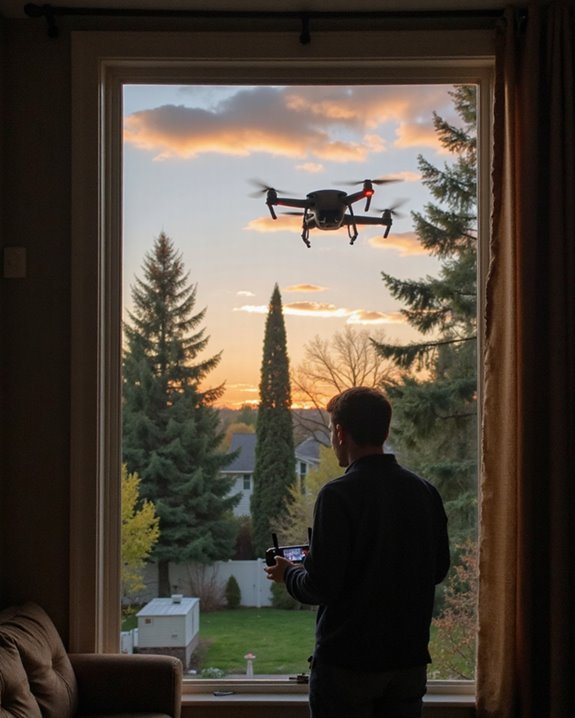
A solid signal connection forms the foundation of any successful indoor drone piloting experience! When controlling your drone from inside, you’ll face challenges like Path Loss, where signal strength naturally weakens over distance as radio waves travel through walls and windows. This attenuation becomes more pronounced with distance and obstacles between your controller and the drone.
Multipath Fading presents another hurdle, occurring when signals bounce off buildings, trees, or metal structures before reaching your drone. These reflected signals can interfere with the primary transmission, causing unexpected control issues!
For best results, position yourself near windows or doorways with direct line of sight to your drone. Remember, materials like concrete and metal are signal’s worst enemies, while elevated antenna placement can work wonders for maintaining that vital connection!
Safety Considerations and Emergency Protocols
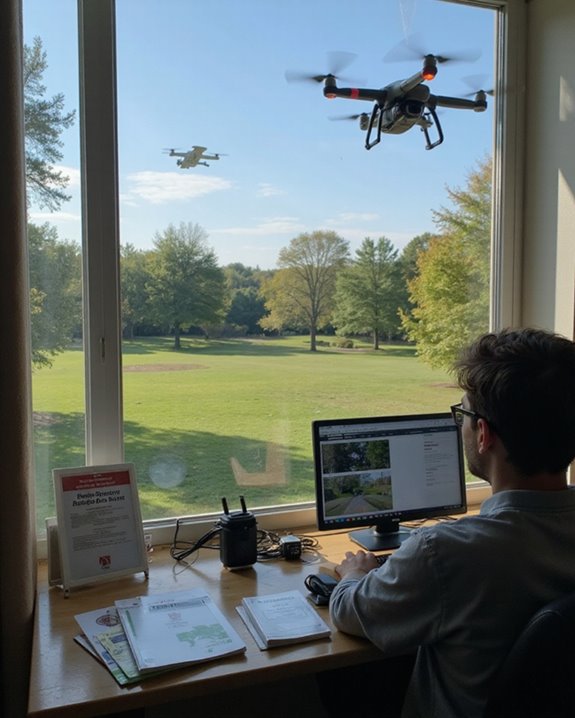
Safety always comes first when piloting a drone from indoors! Maintaining visual line of sight becomes particularly challenging, making regular Safety Audits essential before and during flight. Operators must make sure they’re not exceeding the 400-foot altitude limit, even when flying from inside a building.
Having solid Response Strategies is non-negotiable when piloting from indoors. What will you do if signal strength suddenly drops? Or if an emergency aircraft approaches your flight path? Remember, you’re legally required to give way! Create a clear emergency protocol that includes immediate landing procedures and communication plans with any spotters assisting you.
Don’t forget that flying from moving vehicles is prohibited, except watercraft. And please, keep your drone away from emergency operations – those firefighters have enough to worry about without your drone buzzing overhead!
Weather Impact on Remote Drone Operation

How dramatically can weather conditions affect your indoor drone piloting experience? While you might be cozy inside, your drone faces the full brunt of Mother Nature’s moods! Wind turbulence presents the most significant challenge, with commercial drones typically limited to winds below 22 mph, and even weather-resistant models struggling beyond 31 mph.
Temperature fluctuations also play a vital role in your drone’s performance. When temperatures drop below 32°F, battery efficiency plummets, drastically shortening your flight time. Similarly, exceeding 104°F can trigger protective shutdowns. Add precipitation to the mix, and you’re facing sensor interference, reduced visibility, and potential damage to electronic components. Remember, flying from indoors compounds these challenges since your perspective doesn’t provide the same weather awareness as being outside with your drone!
Best Practices for Indoor Controller Setup
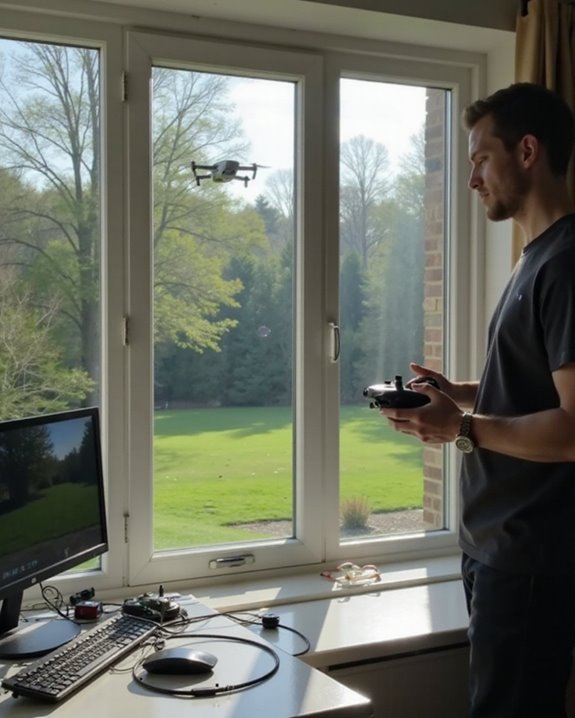
Setting up your controller properly forms the foundation of successful indoor drone piloting! The first step involves thorough Controller Calibration to match your personal preferences, including stick sensitivity adjustments and selecting the most comfortable stick mode. When configuring your remote, set the “Signal Lost” option to HOVER mode, which maintains stability if connection issues arise.
For ideal indoor navigation, enable Vision Systems while disabling features like Smart Return to Home and Obstacle Avoidance, which can interfere with controlled indoor flights. Turn on Display Radar Chart for enhanced awareness of your drone’s position relative to surroundings. Remember, flying indoors requires different settings than outdoor adventures! Keeping your controller properly calibrated guarantees those tight maneuvers around furniture won’t end with your drone becoming an unexpected wall decoration!
Frequently Asked Questions
Can Smartphone-Controlled Drones Be Operated From Inside Buildings Effectively?
Smartphone-controlled drones can be operated from indoor locations, but effectiveness is limited by signal interference, control latency issues, and reduced app integration functionality when physical barriers obstruct wireless connections between controller and aircraft.
How Do Different Building Materials Affect Drone Control Signals?
Dense materials cause increasing signal attenuation, with wood and concrete allowing partial transmission while metal creates significant signal blocking. Thickness and composition directly correlate with control range reduction and potential interference to drone operations.
Are There Special Drones Designed Specifically for Indoor-To-Outdoor Operation?
Nearly 40% of commercial drone applications require both indoor-outdoor versatility. Yes, hybrid drones with crossover features exist specifically for indoor-to-outdoor shifts, incorporating dual navigation systems, adaptable propulsion, and modular designs for seamless environmental shifts.
How Does Altitude Affect Indoor-To-Outdoor Drone Control Capabilities?
Altitude effects greatly impact drone height management during changes. Higher altitudes can reduce signal quality through barriers while improving line-of-sight outdoors. Pilots must adjust for changing control responsiveness and environmental factors at different elevations.
Can Drone Automation Compensate for Indoor Controller Limitations?
While skeptics question reliability, modern drones’ Automation Modes effectively compensate for indoor controller limitations. Pre-programmed flight paths, autonomous obstacle avoidance, and real-time data transmission provide substantial Limit Compensation without requiring direct line-of-sight control.

